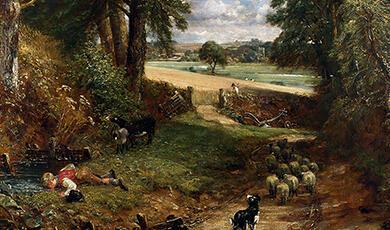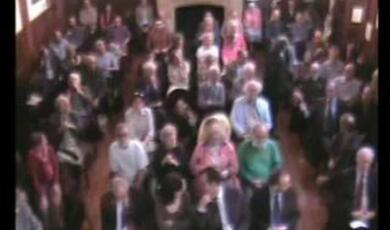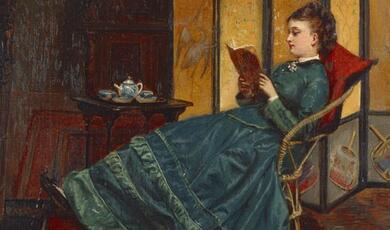High politics and Hellfire: William Hogarth
Share
- Details
- Text
- Audio
- Downloads
- Extra Reading
Infamous rake (and Chancellor of the Exchequer), Sir Francis Dashwood was the founder of the Hellfire Club whose avowed flouting of all moral and sexual decency and the deliberate offending of religion brought about inevitable public outcry. It was for this reason that William Hogarth painted Sir Francis Dashwood at his Devotions, portraying the aristocratic libertine in the posture of St Francis at prayer, replacing the Bible with a copy of an erotic novel and placing a naked woman as the supposed image of his concentration. This clearly scandalous and offensive portrait of his friend was perhaps the perfect depiction of the founder of a club so forcefully (and playfully) out to shock the public.
Robin Simon, editor of The British Art Journal, will speak on the portrait, the men involved and the world of 18th Century London in which such strange things could occur.
Download Text
HIGH POLITICS AND HELLFIRE: WILLIAM HOGARTH'S PORTRAIT OF FRANCIS DASHWOOD
Robin Simon
[NOTE that [ILL] refers to a change of image]
Good afternoon. I hope you are feeling robust! Because we are going to explore the rather one-track humour of the English upper classes in the 18th century.
Even in an age of political patronage - or of corruption, as one might more accurately call it - the appointment by the Prime Minister, Lord Bute, of Sir Francis Dashwood as, first, Treasurer of the Chamber in 1761, and then in 1762 as Chancellor of the Exchequer, stunned the chattering classes of Georgian England. To compound this act of favouritism, Dashwood himself lost no time in securing a government pension of £800 a year for his very close friend Paul Whitehead - to whom we shall return. The main point for now is that Paul Whitehead is the person most likely to have been responsible for the commissioning of Hogarth's portrait of Sir Francis Dashwood at his devotions [ILL] which dates from about 1751. Whitehead organized Dashwood's famous Hellfire Club, the Monks of Medmenham or "Order of the Friars of St Francis of Wycombe". West Wycombe was Dashwood's country house [ILL], and Medmenham a house on the river which he rented [ILL]. And Whitehead was also a very close friend of Hogarth. He wrote poetry about him; was a fellow-member of the Sublime Society of Beef Steaks; was satirized together with Hogarth by Charles Churchill; and his verses appear in Hogarth's last engraving:Time Smoking a Picture [ILL]:
"As statues moulder into worth".
The painting [ILL] reflects a general perception that Hogarth shares with Alexander Pope, and that is the possibility latent in Roman Catholic baroque art for confusion between the flesh and the spirit, at the very time that it most earnestly endeavours to exalt the spirit through the senses. One thinks of Pope's verses upon the excesses of the Duke of Chandos's chapel at Cannons - it survives, rather improbably, as St Lawrence, Little Stanmore [ILL, ILL]:
"On painted Ceilings you devoutly stare,
Where sprawl the Saints of Verrio and Laguerre,
On gilded clouds in fair expansion lie,
And bring all Paradise before your Eye. [Moral Essays, "Epistle to Burlington", ll. 145-8]
The saints in question are female, and the "fair expansion" opens their legs, offering a vision of the Mohammedan conception of paradise as copulation with virgins. In Hogarth's picture [ILL], Dashwood's eyes are fixed on the "fair expansion" offered by the female nude with her legs spread wide upon his "altar". Her mouth is open in abandon, and Hogarth and Pope's perception was shared by their contemporary, Charles de Brosses [ILL], who famously observed of Bernini's orgasmically ecstatic St Teresa [ILL, ILL]:
"If that is divine love, I know it very well."
I confess that when this comparison first occurred to me, it seemed just a pleasing coincidence. But it turned out that there are more substantial grounds for thinking that it was this very sculpture that was in the mind of both Dashwood and Hogarth. This same Charles de Brosses of the defining witticism had actually met Dashwood in Rome in January/February 1740. Furthermore, he records in considerable detail the scandalous activities of "the cavaliere Ashwood", whom he describes as "one of the funniest people alive", and he witnessed Dashwood acting out a number of anti-papal and anti-Roman Catholic parodies. Shortly after his return home, Dashwood had these high jinks commemorated by Carpentiers in a portrait which showed him as a pope [ILL] - Pope "Innocent" (there is nothing terribly subtle about much of this!) - sacrilegiously blessing a glass of wine before a female herm which has one breast exposed. It is merely hindsight of course that lends this image another twist, in its unnerving resemblance to a more recent Chancellor of the Exchequer of our own day [Gordon Brown]
When de Brosses saw him in Rome, Dashwood was taking part, for example, in a parody of the papal conclave that followed the death of Clement XII on 6 February 1740. For this, he dressed up as Cardinal Ottoboni [ILL], not least (it seems) because that great patron of the arts had been in favour of the papal ban on freemasonry that had come into effect (1738) shortly before Clement's death. De Brosses recalled that Dashwood also sang anti-papal songs. Dashwood had rather a nerve to parody Ottoboni, because he amply reflected in his own behaviour the Cardinal's scandalous habits, at least, as they were described by de Brosses:
"Ottoboni was made cardinal at the age of 16 or 17, [he was] without morals, without beliefs, debauched, ruined, a lover of the arts and a great musician."
But perhaps that was the point. In fact, no sooner had Ottoboni entered the conclave that Dashwood was making fun of than he was forced to leave it, on 25 February, through ill health, and he died four days later.
De Brosses found the whole papal election something close to farce (the conclave, the longest in modern times, lasted six months, Pope Benedict XIV only being elected on 17 August 1740), and the antics of Dashwood and the English papists present only heightened the general chaos and lack of decency:
The cavaliere Ashwood, one of the funniest people alive, threw off his periwig, and dressed up as the senior cardinal; Stafford [John Paul Stafford-Howard, 4th Earl of Stafford] and the "cardinal" Legouz [Legouze de Gerland, like de Brosses, from Dijon; he went to England after this] made themselves pries and deacon of the scrutiny [of the papal ballot]. This "cardinal" Stafford, apparently of the house of Howard, is one of the worst catholics that I know. Dashwood imitated, to the life, the role of Cardinal Ottoboni, and began to intone the the Oremus [let us pray] in a trembling voice, with prayers, I can assure you, are nowhere to be found in the liturgy; but you had to laugh. This damned protestant has at his command an entire repertory of dirty songs about the papacy: indeed, a true scandalum magnatum. [by the way, Alberoni was elected, but there never was an election quite so lacking in its attention to the rules.
Dashwood had not done with the Vatican. His most notorious escapade followed, when he made all too literal the purely ritual scourging of penitents gathered in the Sistine Chapel for Good Friday, where each person was handed upon entry a symbolic and ineffectual scourge. When the lights were extinguished Dashwood brought out a real horsewhip that he had smuggled into the chapel and set about lashing out at everyone he could reach, before making good his escape, amid terrified shouts of "Il Diavolo! Il Diavolo!"
Hogarth's parody [ILL] operates at several levels. It parodies a saint at his devotions, and not for the first time Hogarth appears to have had in mind an etching by Agostino Carracci, St Francis at his devotions [ILL], which features the haloed saint in a similar attitude and rocky landscape setting. In Hogarth's painting [ILL] each of the standard props that one might expect to find in such a scene is replaced by something more secular or sexually suggestive. The Bible, for instance [ILL], is supplanted by an erotic volume entitled "DE / ELEGANTIAE /LATINI /SERMONIS /... / ROCHESTER". The name "Rochester" refers to John Wilmot, 2nd Earl of Rochester, the most notorious and brilliant pornographic poet of the Restoration period, and the Latin phrase suggests that this is a commentary by him upon what amounted to an encyclopaedia of sexual and erotic knowledge that was famous throughout Europe at the time, a work that was widely known simply as "Meursius". This book was referred to by Casanova, for example, as featuring in a significant early incident in his life. Although written by Nicholas Chorier (1612-92), it passed under the pseudonymous title "Johannis Meursii Elegantiae Latini Sermonis", as though it were by the respectable, indeed tedious, Dutch scholar Johannes van Meurs.
The title phrase in itself was a provocative reference to a decision of the Council of Trent that allowed the Roman Catholic devout to read obscene material if it was for the genuine purpose of improving literary style - "propter sermonis elegantiam" - a perilous splitting of hairs that almost invites a parody such as that of Hogarth and Dashwood. The presence of this work in place of a Bible is itself a reference to Medmenham Abbey, which was equipped with a substantial library, pornographic and erotic books, naturally, but also a Bible. The Bible survives, containing letters with evidence of what went on.
The figure of Christ upon a Crucifix present in the standard images of saints at devotion is supplanted by a female nude; the usual memento mori of a skull is now a carnival mask; and the saintly halo [ILL] is occupied by a devilish-looking profile resembling Dashwood's close friend Lord Sandwich, who was his partner in crime and a fellow-member of the Society of Dilettanti. It is an interesting point that Hogarth painted Sandwich's young son, The Hon Edward Montagu, in about 1749-50, close in date to the Dashwood portrait. Whether or not Sandwich himself is represented, the profile in the halo is certainly intended to suggest a satyr, thus making an additional sly joke or double meaning. As a matter of fact, the Society of Dilettanti had a chair carved with satyrs, which can be seen in the Dillettanti portrait of Lord Galway [ILL], who is seen dressed as a Cardinal. This was painted in 1743, shortly after Dashwood's return from Rome.
At Medmenham, the "rites" in the "chapel" may have included some sort of parody of ancient Greek mysteries, with naked women stretched out in "fair expansion" on the "altar", with their legs spread wide: and so there is perhaps an allusion to this too in Hogarth's painting [ILL]. The composition also contains a striking juxtaposition of a pile of exotic fruit with the Crucifix dangling on a rope of pearls, tied with a pretty ribbon to a branch. The branch can be understood as an erect penis pointing directly towards the relevant part of the nude, and the ribbon must surely be intended to recall the usual contemporary method of attaching a prophylactic. In any event, this conjunction of the sacred and profane, of sexual indulgence and religious symbol exploited merely as decoration, brings to mind another couplet in Pope's Rape of the Lock:
On her white Breast a sparkling Cross she wore
Which Jews might kiss, and infidels adore. [The Rape of the Lock, II, ll. 7-8]
Moreover, the still-life of rich fruit itself contains more visual jokes: male genitalia in the front, and, while we have heard of somebody having a bottom like a peach, here is Hogarth showing a peach unmistakably like a bottom [ILL].
The Crucifix in Dashwood at his devotions [ILL] forms a parody within the larger parody, because where the twisting figure of the Crucified is seen against the Cross - and the wood of a cross can still be seen - the sensuous female nude, in a closely related but decisively different pose, is understood to be writhing in pleasure upon what can be taken for a bed-sheet. Furthermore, Hogarth's painting revolves upon his making literal a slang metaphor then current, and familiar in the circle of Pope and Swift whose friend, the sexually insatiable Henry St John, Lord Bolingbroke, would frequently excuse himself from their company in order to have a woman, saying that he was "going to his devotions". And the same usage was common among the members of Dashwood's hell-fire club. There is another "literalism" in Hogarth's painting, however, that adds another layer of meaning: it was Dashwood's habit to dress in a habit when indulging in the sexual excesses of "The Order of the Friars of St Francis of Wycombe", and to adopt the nom de guerre "St Francis". Dashwood had already been painted in this persona (as "San Francesco di Wycombo") by George Knapton in 1742, for the Society of Dilettanti [ILL], a portrait in which he also appears staring at a female nude, to be precise, the Venus de' Medici (there is a cast of the sculpture still in the dining room at West Wycombe house), and he had evidently chosen to adopt this "saintly" guise before this date. Similarly, the women who came to the "devotions" of the "Brothers" were referred to as if they were nuns ("Sisters").
Hogarth's painting of Dashwood [ILL] is later than Knapton's, like that of Carpentiers [ILL] and was probably painted in the early 1750s. Dashwood signed the lease for Medmenham in 1751, and the "Order" was fairly under way, after the completion of various inventive works, the following year, and Hogarth's portrait must be datable to this time [ILL]. It is partly a variation on the theme of Knapton's, but specifically redirecting the subject of satire towards the excesses of baroque religious art. And, to return to my earlier suggestion, it does seem likely that the orgasmic nude, with her head to one side and her mouth open, was suggested by Dashwood, on the basis of his own reaction, like that of De Brosses, to Bernini's St Teresa [ILL Bernini, ILL]. The position of the left arm [ILL Hogarth] is different from that in the sculpture, although the presence of drapery around the head is a common feature, while Hogarth's very stripping away of St Teresa's voluminous (but suggestive) draperies [ILL Bernini] might itself be understood as a deliberate element of the parody: the draperies around and beneath his nude are almost as extensive [ILL Hogarth]. St Teresa appears, of course, directly above the altar of the Cornaro Chapel [ILL Bernini], while Dashwood's female is displayed upon what ought to be an altar [ILL Hogarth]; and St Teresa is supported by what appear to be rocks (although intended for clouds) [ILL Bernini], as is the nude in Hogarth's picture [ILL]. Significantly, as originally planned Hogarth's nude had her left leg dangling over the rock's edge precisely like that of St Teresa [ILL]: the pentimento - alteration - to the left leg is now very evident. And this bare foot of St Teresa [ILL] finds echoes elsewhere in Hogarth's paintings: Bernini's is, in a way, as suggestive as that emerging from behind the curtain in "The Tête à Tête" of Marriage A-la-Mode [ILL], and that of the Countess in the fifth scene of the same series [ILL]. In Bernini's sculpture this "sexy" bare foot [ILL Bernini] is, incidentally, a careful reference to St Teresa's having been a Discalced Carmelite - a barefoot Carmelite - and the fact that St Teresa was a nun, and therefore a "Sister", can probably also be understood as another punning literalism in Hogarth's painting, referring to Dashwood's profane "Order". Of course, one would expect a real St Francis also be depicted with a bare foot, and it is one of the more unsettling little details of Hogarth's Dashwood that, emerging from beneath his monkish habit is not a bare foot but a fashionable high-heeled velvet boot [ILL].
Hogarth's Dashwood is posed in relation to the nude as Bernini's angel is towards the saint [ILL Hogarth] [ILL Bernini, whole]; and if this comparison holds water - I think it does - then one might reflect that the rays of light beaming upon the private parts of the Medici Venus in Knapton's earlier portrait for the Dilettanti [ILL Knapton, colour] also have their inspiration in the [ahem, golden shower] of gilded rays that flood down upon St Teresa in Bernini's mise-en-scène. The point in Knapton's portrait, which was painted immediately after Dashwood's return from Rome, is that the Christian original (the Madonna) is supplanted by a pagan goddess who is the object now of sexual adoration. The removal of the hand shielding the pudenda may be a deliberate twist on the word "pudica", "modest" or "chaste", that identified the related Antique sculpture then on view in Florence alongside the Medici Venus [ILL] in the Tribuna of the Uffizi, the "Venus pudica". Dashwood's object of veneration is the opposite, "shameless" [ILL], and all kinds of things may be expected from the conjunction of himself, the goddess's pudenda, and the chalice. But, in addition, the removal of the statue's hand was also a learned antiquarianism, of a kind that reflected the more serious aspect of the Dilettanti's sponsorship into classical research, since the arms and hands of the Medici Venus [ILL] were known to have been restored by Ercole Ferrata in the latter 17th century and were famously the subject of debate. Indeed, our friend Charles de Brosses (in Italy 1739-40) had only recently met none other than Dashwood's friend the notorious "mylord Sandwich" in front of this very statue, where they discussed such aspects of its beauty at some length.
The chalice Dashwood holds [ILL] is inscribed "Matri [Omnium] Sanctorum", which ought to be a reference to the Virgin Mary, but her replacement by a Venus asserts that Venus, the goddess of love, is the "mother of all the saints", that is to say, the members of Dashwood's hellfire "Order". The parody is obviously akin to that operating in the Hogarth portrait, where Dashwood is worshipping a secular "Venus" in another parody of Christianity and where there is an additional twist or layer of satire present if the "Venus" there is indeed based upon the pose of Bernini's saint.
It should not be supposed that Dashwood's interest in sexual innuendo was unusual for the time: I did refer right at the start to the one-track minds of the Georgian upper classes... and Hogarth certainly was closely familiar with their rampant sex lives. His delightful Hervey conversation piece [ILL] provides a window into this world where bisexuality was frequent and syphilis was, one sometimes feels, almost the commonest cause of death. Hogarth's portrait group of 1738 celebrates a group of men whose allegiance was to Prime Minister Walpole and the King's court, a opposed to allegiance to the estranged Frederick, Prince of Wales. It is, on the face of it, an amiable assertion of party solidarity. Hervey's golden key reveals him as Vice-Chamberlain of the Royal Household; the 3rd Duke of Marlborough (in red) had just gone over to the King's party; Henry Fox (in blue) had just been made Surveyor of the King's works. But it also revolves around the common knowledge that Hervey and Stephen Fox (seated in green) were lovers over a full decade and the composition parodies those decorous illustrations of heterosexual family life developed by Hogarth himself [ILL]. In this instance there are no women present [ILL] and the two principal homosexual partners, Fox and Hervey, adopt the poses usually taken in Hogarth's conversations by husband and wife. "Ste" Fox is seated at a table, where his gestures would suggest that he might be dispensing tea while Hervey at the centre takes the role of male head of the household. A complication is that the clergyman - eying the benefice presented him by "Ste", who is tipping him into the river - has just conducted Ste's marriage to a thirteen-year-old heiress - without her mother's consent.
Hervey, of course, was notoriously satirised by Pope as Sporus, the name of Nero's castrated slave-"wife", and every line of Pope's verse makes sly reference to the alternative roles of homosexual encounters:
His Wit all see-saw between that and this,
Now high, now low, now Master up, now Miss,
... Fop at the Toilet, Flatt'rer at the Board,
Now trips a Lady, and now struts a Lord.'
By the date of Hogarth's portrait group, 1738, Hervey's looks were fading, which he disguised with copious powder and rouge. According to Sarah, Duchess of Marlborough, he was already without "a tooth in his head" and in December 1735 he had acquired false teeth, "the finest set of Egyptian pebbles you ever saw", the result of dosing his syphilis with mercury: he was dead at 46 in 1743. When he died, Hervey bequeathed to the MP at the right, Thomas Winnington, a male lover in the form of Horace Walpole's subsequent object of adoration, Lord Lincoln, described by Walpole as the "stallion of the age" and reputed to have a penis of prodigious size. With the exception of Horace Walpole, most in this circle were married bisexuals and died young of syphilis. Another friend, Charles Hanbury Williams, ambassador to Russia, who shortly afterwards shot himself in the final stages of syphilitic dementia, wrote a letter about Hervey's "bequest" of Lord Lincoln in endless double entendres.
And those double meanings were habitual. Homosexuality was illegal at this time, and as a result, the correspondence and conversation of homosexuals was shot through with code, puns and double entendres, in order to avoid the ever-present threat of blackmail by servants or professional blackmailers to whom servants knew to turn for ready cash. The same was true of rampant heterosexuals such as Dashwood: again the danger of blackmail made double-entendres normal. The point is that nothing could have been more suited to Hogarth's particular cast of mind, to whom parody and double meanings were instinctive: they form, one might say, the very foundation of his art.
There was, then, nothing unusual in Dashwood's fascination with sex, it was only the degree to which this improbable Chancellor of the Exchequer took his sexual entertainment that was out of the ordinary. Because it is not only in the paintings and sculptures - [ILL] his garden arcade includes the bottom-up Hermaphrodite, predictably - that Dashwood indulged himself. The whole landscape of his park at West Wycombe originally contained sexual jokes, some of which could only be recognized when seen from above, high up in the golden globe or outside the Mausoleum [ILL] where the view to the grounds below revealed certain swellings in the ground and strategically placed clumps of shrubs and lakes indicating female forms. More plainly, there was and still is a "Temple of Venus" in the grounds [ILL] in the form of a "Rotondo" that housed a Venus de' Medici (replaced, strangely, by a Venus de Milo in Quinlan Terry's reconstruction of 1982). The temple is set upon a "Mound of Venus" (you see, there is nothing too subtle about the jokes!), an obvious double-entendre, and within the Mound is (or was, originally) a "Parlour of Venus" entered through an oval-shaped entrance of, once you think about it, very obvious design. This doorway was even referred to at the time as the "gateway of life". Stowe, too, another famous National Trust garden, was designed along similar lines, under the direction of Bridgeman, Vanburgh, Gibbs and Kent in the 1720s and '30s, and includes Kent's Temple of Venus of 1731 [ILL]. Although externally less explicit than that at Wycombe, its interior contained what was known as a "pleasuring sopha" set below very explicit ceiling paintings by Francesco Sleter of sexual intercourse. The Temple's apparently decorous adornment with Roman busts on the exterior is itself ambivalent, since they are of two sexually notorious emperors, Nero and Vespasian, and two adulteresses, Cleopatra and Faustina.
The Stowe Temple of Venus looks directly across the lake towards the Rotunda, which contains a gilded Venus de' Medici [ILL], whose role in the gardens and their buildings emphasized the goddess's capacity to promote sexual trouble. Of which there was evidently plenty? Gilbert West's poem of 1732, Stowe, The Gardens of the Right Honourable Richard Lord Viscount Cobham, Address'd to Mr. Pope, contains a memorable celebration of a sexual episode featuring Cobham's former regimental chaplain, the vicar of Stowe, the aptly named Revd. Cornwell Rand, as a result of which "Dido's Cave", another garden feature, was renamed "The Randibus". West's account of the episode wittily echoes Virgil's description of the pursuit of Dido by Aeneas, although the chase he describes was the result of Rand's becoming inflamed by a girl on a swing, whose dress was increasingly disturbed by the breeze:
At length the last, white, subtile veil withdrew,
And those mysterious Charms expos'd to view...
Rand pounced on the girl but she ran away, with Rand following in hot pursuit, until the girl was cornered in Dido's Cave where the inflamed clergyman took her by force.
Sometimes, of course, these private goings-on became public knowledge, and none more so than the activities of Dashwood's hellfire club, especially when he came to hold high public office in the 1760s and fell out with the dangerous John Wilkes [ILL] himself a former Medmenham "monk". I have much enjoyed the writings of apologists for Dashwood, one of whom, and not so long ago, decided that the monks of Medmenham were merely high-spirited; that no sexual impropriety took place; and that they chiefly enjoyed dressing up for boating parties on the Thames? The author cannot have looked very closely, if at all, at Hogarth's painting [ILL] or indeed the others we have glanced at. Contemporaries, however, were in absolutely no doubt, and in their minds the two things - Dashwood's political corruption and private immorality - came together in at least one notable satire [ILL], The Secrets of the Convent of 1765. And here we return to Paul Whitehead, poet, friend of Hogarth, and beneficiary of that state pension of a cool £800 a year arranged for him by Dashwood who was himself the object, we remember, of Prime Minister Lord Bute's favouritism. Whitehead was very close indeed to Dashwood: he lived with him at West Wycombe and was Secretary and Steward of the "The Order of the Friars of St Francis of Wycombe" at Medmenham, which meant that he effectively ran everything to do with the hellfire club. When Whitehead died he left his heart to Dashwood who, characteristically, had it solemnly interred within a marble urn in the mausoleum at West Wycombe [ILL], to the accompaniment of an elaborate military procession and an orchestra playing the "Dead March" from Saul. As might have been expected, Whitehead's heart could be taken out and shown to visitors. Equally predictably, it was stolen in 1829.
Whitehead's appearance with Dashwood in The Secrets of the Convent[ILL] is then entirely to be expected. The print takes Knapton's Dilettanti portrait of Dashwood as its visual point of departure - here is the Venus de' Medici again, and the chalice - and both Whitehead and Dashwood are seen in habits as members of the "Order of the Friars of St Francis of Wycombe". In the verses below the image, "Friar Paul", at the left, is Whitehead; "St Francis" , seen at the right, is, of course, Dashwood; and "Laird Boot" is Bute. But you need to know that the phrase "jewel-office" is not only a reference to the treasury but also a sexual double entendre, since "jewels" was the term for sexual organs, a reference to which muchmore obviously concludes the poem:
Once upon a Time, as Fame reported,
When Friar Paul St Frances courted,
Thus Frances answered, your no Novice,
You well deserve the Jewel-Office.
A place of Trust your Faith will suit,
You shall demand it of Laird Boot.
Your MANNERS, Morals, Virtue, Grace
Call loudly for a goodly Place.
Success attend you, I'll be blunt
My dearest Brother here is -.
Well, don't say I didn't warn you... Thank you.
[ends]
©Robin Simon, Gresham College, 03 November 2008
This event was on Mon, 03 Nov 2008
Support Gresham
Gresham College has offered an outstanding education to the public free of charge for over 400 years. Today, Gresham College plays an important role in fostering a love of learning and a greater understanding of ourselves and the world around us. Your donation will help to widen our reach and to broaden our audience, allowing more people to benefit from a high-quality education from some of the brightest minds.


 Login
Login







